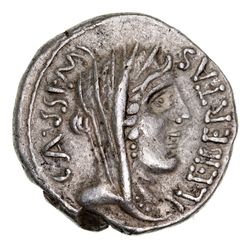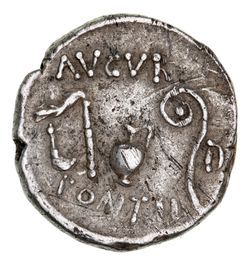Roman Silver & Bronze - Imperatorial
Lot 2535 SESSION 14 (2.30PM THURSDAY 27TH NOVEMBER) Roman Silver & Bronze - Imperatorial
Estimate $500
Bid at live.noble.com.au
CASSIUS, (43-42 B.C.) / Julius Caesar, (early 46 B.C.), silver denarius, hybrid/mule or barbarous copy of issue of the obverse Smyrna moving with Brutus and Cassius and of the reverse issued Utica? North Africa mint, (3.23 g), obv. diademed head of Liberty to right, upwards on left CASS. IMP, upwards on right I LEIBERTAS around, rev. emblems of the augurate and pontificate, simpulum, aspergillum, jug and lituus, AVGVR above PONT II below, D to right, (S.1447/2 & 1403/1, Sear Imperator. 223 & 57, Vagi 103 & 45, Cr.500/5 & 467/1a, Syd.1305 & 1023, RSC Cassius #6 & Julius Caesar #4a). Very fine or better, a most interesting mule of barbarous style, extremely rare.
Ex Anthony (Tony) Taylor Collection.^Noble Numismatics Sale 114, lot 4284. Also Dr Adrian Carr Collection and purchased in 2002, from Tzvetomir Boev on an ebay auction (hermescoins1).^^Dr Carr comments: "This is a fascinating and enigmatic coin produced from barbarous mixed dies. Clearly a struck piece in silver that, in theory, could not have been produced from the original dies as these dies are 4 years apart. The dies are of fine style. The original obverse, of course, is that from a coin of Cassius and is associated with the meeting of Cassius and Brutus at Smyrna. The original die was struck by Lentulus Spinther, the infamous assassin's lieutenant. The original reverse is thought to have been struck in 46 B.C., to pay Caesar's troops after the battle of Thapsus - 6th April 46 B.C. Sear suggests the Caesar pieces were struck at Utica, Africa.^^Hybrid coins with what at first glance may seem improbable combinations, are known to exist. Harlan Berk in his 134th Buy or Bid Sale lists a hybrid of Mark Antony and Augustus, struck from dies that are from types thought to be separated by some 20 years and from different mints. Again the silver is good and the strike appears to be genuine. If this Cassius/Caesar coin is an ancient forgery, then the fine style might suggest the coin was produced in Gaul or perhaps Northern Italy. It has also been suggested the piece might have been pre-Augustan or early in the time of Augustus when monetary supply was slightly problematic.^^To have a coin that is a mixture of a reference to Caesar and one of his assassins, is clearly a fascinating piece. There is also much emerging in the field to suggest that contemporary 'forgeries' were motivated by either an attempt to deceive, such as plated and debased coins, or simply to supplement official coinage that was locally in short supply. It is argued by some (see Warren Esty website) that regional governors, local army commanders and/or rich local persons may have struck coinage as the government failed to send adequate supply. This coin is clearly an enigma struck in silver of high fineness".
Estimate / sale price does not include buyer's premium (currently 22% including GST) which is added to hammer price. All bids are executed on the understanding that the Terms & Conditions of sale have been read and accepted. For information on grading and estimates please refer to the Buying at Auction advice.
Quick find
View a lot by number and sale.
Adjacent lots
Lot 2533
C. CASSIUS LONGINUS, (died 42 B.C.), denarius, issued Spring 42 B.C., military mint in the ...
Estimate $3,000
Lot 2534
C. CASSIUS LONGINUS, (died 42 B.C.), denarius, issued Spring 42 B.C., mint travelling with Cassius ...
Estimate $1,200
Lot 2535 This lot
CASSIUS, (43-42 B.C.) / Julius Caesar, (early 46 B.C.), silver denarius, hybrid/mule or barbarous copy ...
Estimate $500
Lot 2536
MARK ANTONY, (38 BC), silver denarius (3.30g), Athens mint, obv. veiled togate figure of Marc ...
Estimate $200
Lot 2537
MARK ANTONY, (32-31 B.C.), silver denarius, mint moving with Mark Antony, (3.56 g), obv. praetorian ...
Estimate $700

